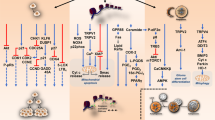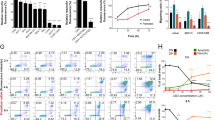Abstract
Δ9-Tetrahydrocannabinol, the main active component of marijuana, induces apoptosis of transformed neural cells in culture. Here, we show that intratumoral administration of Δ9-tetrahydrocannabinol and the synthetic cannabinoid agonist WIN-55,212-2 induced a considerable regression of malignant gliomas in Wistar rats and in mice deficient in recombination activating gene 2. Cannabinoid treatment did not produce any substantial neurotoxic effect in the conditions used. Experiments with two subclones of C6 glioma cells in culture showed that cannabinoids signal apoptosis by a pathway involving cannabinoid receptors, sustained ceramide accumulation and Raf1/extracellular signal-regulated kinase activation. These results may provide the basis for a new therapeutic approach for the treatment of malignant gliomas.
This is a preview of subscription content, access via your institution
Access options
Subscribe to this journal
Receive 12 print issues and online access
$209.00 per year
only $17.42 per issue
Buy this article
- Purchase on Springer Link
- Instant access to full article PDF
Prices may be subject to local taxes which are calculated during checkout





Similar content being viewed by others
References
Pertwee, R.G. Pharmacology of cannabinoid CB1 and CB2 receptors. Pharmacol. Ther. 74, 129–180 (1997).
Felder, C.C. & Glass, M. Cannabinoid receptors and their endogenous agonists. Annu. Rev. Pharmacol. Toxicol. 38, 179–200 (1998).
Matsuda, L.A., Lolait, S.J., Brownstein, M., Young, A. & Bonner, T.I. Structure of a cannabinoid receptor and functional expression of the cloned cDNA. Nature 346, 561–564 (1990).
Munro, S., Thomas, K.L. & Abu-Shaar, M. Molecular characterization of a peripheral receptor for cannabinoids. Nature 365, 61– 65 (1993).
Devane, W.A. et al. Isolation and structure of a brain constituent that binds to the cannabinoid receptor. Science 258, 1946–1949 (1992).
Di Marzo, V. et al. Formation and inactivation of endogenous cannabinoid anandamide . Nature 372, 686–691 (1994).
Stella, N., Schweitzer, P. & Piomelli, D. A second endogenous cannabinoid that modulates long-term potentiation. Nature 388, 773– 778 (1997).
Childers, S.R. & Breivogel, C.S. Cannabis and endogenous cannabinoid systems. Drug Alcohol Depen. 51, 173– 187 (1998).
Di Marzo, V., Melck, D., Bisogno, T. & De Petrocellis, L. Endocannabinoids: endogenous cannabinoid receptor ligands with neuromodulatory action. Trends Neurosci. 21, 521–528 (1998).
Grinspoon, L. & Bakalar, J.B. Marihuana as medicine: a plea for consideration. J. Am. Med. Assoc. 273, 1875–1876 (1995).
Voth, E. & Schwartz, R. Medicinal applications of delta-9-tetrahydrocannabinol and marijuana. Ann. Intern. Med. 126, 791 –798 (1997).
De Petrocellis, L. et al. The endogenous cannabinoid anandamide inhibits human breast cancer cell proliferation. Proc. Natl. Acad. Sci. USA 95, 8375–8380 (1998).
Sánchez, C., Galve-Roperh, I., Canova, C., Brachet, P. & Guzmán, M. Δ9-Tetrahydrocannabinol induces apoptosis in C6 glioma cells. FEBS Lett. 436 , 6–10 (1998).
Barth, R.F. Rat brain tumor models in experimental neuro-oncology: the 9L, C6, T9, F98, RG2 (D74) RT-2 and CNS-1 gliomas. J. Neurooncol. 36 , 91–102 (1998).
Shinkai, Y. et al. RAG-2-Deficient mice lack mature lymphocytes owing to inability to initiate V(D)J rearrangement. Cell 68, 855–867 (1992).
Louis, D.N. & Gusella, J.F. A tiger behind many doors: multiple genetic pathways to malignant gliomas. Trends Genet. 11, 412–415 (1995).
Maintz, D. et al. Molecular genetic evidence for subtypes of oligoastrocytomas . J. Neuropathol. Exp. Neurol. 56, 1098– 1104 (1997).
Röser, K., Bohn, W., Giese, G. & Mannweiler, K. Subclones of C6 rat glioma cells differing in intermediate filament protein expression . Exp. Cell Res. 197, 200– 206 (1991).
Baudet, C. et al. 1,25-Dihydroxyvitamin D3 induces programmed cell death in rat glioma cell line. J. Neurosci. Res. 46 , 540–545 (1996).
Sánchez, C., Galve-Roperh, I., Rueda, D. & Guzmán, M. Involvement of sphingomyelin hydrolysis and the mitogen-activated protein kinase cascade in the Δ9-tetrahydrocannabinol-induced stimulation of glucose metabolism in primary astrocytes. Mol. Pharmacol. 54, 834–843 ( 1998).
Blázquez, C., Sánchez, C., Daza, A., Galve-Roperh, I. & Guzmán, M. The stimulation of ketogenesis by cannabinoids in cultured astrocytes defines carnitine palmitoyltransferase I as a new ceramide-activated enzyme. J. Neurochem. 72, 1759–1768 (1999).
Ariga, T., Jarvis, W.D. & Yu, R.K. Role of sphingomyelin-mediated cell death in neurodegenerative diseases. J. Lipid Res. 39, 1– 16 (1998).
Kolesnick, R.N. & Krönke, M. Regulation of ceramide production and apoptosis. Annu. Rev. Physiol. 60, 643–665 (1998).
Marshall, C.J. Taking the Rap. Nature 392, 553– 554 (1998).
Morrison, D.K. & Cutler, R.E., Jr. The complexity of Raf-1 regulation. Curr. Opin. Cell Biol. 9, 174–179 (1997).
Zhang, Y. et al. Kinase supressor of Ras is ceramide-activated protein kinase . Cell 89, 63–72 (1997).
Nicotera, P., Leist, M. & Manzo, L. Neuronal cell death: a demise with different shapes. Trends Pharmacol. Sci. 20, 46–51 (1999).
Price, D.L. New order from neurological disorders. Nature 399, A3–A5 (1999).
Huwiler, A. et al. Ceramide binding and activation defines protein kinase c-raf as a ceramide-activated protein kinase. Proc. Natl. Acad. Sci. USA 93, 6959–6963 ( 1996).
Müller, G. et al. Regulation of Raf-1 kinase by TNF via its second messenger ceramide and cross-talk with mitogenic signalling. EMBO J. 17, 732–742 (1998).
Michaud, N.R. et al. KSR stimulates Raf-1 activity in a kinase-independent manner . Proc. Natl. Acad. Sci. USA 94, 12792– 12796 (1997) (correction 95, 2714, 1998).
Derkinderen, P., Enslen, H. & Girault, J.A. The ERK/MAP-kinases cascade in the nervous system . NeuroReport 10, R24–R34 (1999).
Pumiglia, K.M. & Decker, S.J. Cell cycle arrest mediated by the MEK/mitogen-activated protein kinase pathway. Proc. Natl. Acad. Sci. USA 94, 448– 452 (1997).
York, R.D. et al. Rap1 mediates sustained MAP kinase activation induced by nerve growth factor. Nature 392, 622– 626 (1998).
Mohr, S., McCormick, T.S. & Lapetina, E.G. Macrophages resistant to endogenously generated nitric oxide-mediated apoptosis are hypersensitive to exogenously added nitric oxide donors: Dichotomous apoptotic response independent of caspase 3 and reversal by the mitogen-activated protein kinase kinase (MEK) inhibitor PD 098059. Proc. Natl. Acad. Sci. USA 95, 5045– 5050 (1998).
Murray, B., Alessandrini, A., Cole, A.J., Yee A.G. & Furshpan, E.J. Inhibition of the p42/p44 MAP kinase pathway protects hippocampal neurons in a cell-culture model of seizure activity. Proc. Natl. Acad. Sci. USA 95, 11975–11980 (1998).
Martuza, R.L. Act locally, think globally. Nature Med. 3, 1323 (1997).
Laske, D.W., Youle, R.J. & Oldfield, E.H. Tumor regression with regional distribution of the targeted toxin TF-CRM107 in patients with malignant brain tumors. Nature Med. 3, 1362–1368 (1997).
Ram, Z. et al. Therapy of malignant brain tumors by intratumoral implantation of retroviral vector-producing cells. Nature Med. 3 , 1354–1361 (1997).
Mason, W., Louis, D.N. & Cairncross, J.G. Chemosensitive gliomas in adults: which ones and why? J. Clin. Oncol. 15, 3423– 3426 (1997).
Avgeropoulos, N.G. & Batchelor, T.T. New treatment strategies for malignant gliomas. Oncologist 4, 209–224 (1999).
Skaper, S.D. et al. The ALIAmide palmitoylethanolamide and cannabinoids, but not anandamide, are protective in a delayed postglutamate paradigm of excitotoxic death in cerebellar granule neurons. Proc. Natl. Acad. Sci. USA 93, 3984–3989 ( 1996).
Shen, M. & Thayer, S.A. Cannabinoid receptor agonists protect cultured rat hippocampal neurons from excitotoxicity. Mol. Pharmacol. 54, 459–462 ( 1998).
Nagayama, T. et al. Cannabinoids and neuroprotection in global and focal cerebral ischemia and in neuronal cultures. J. Neurosci. 19, 2987–2995 (1999).
Hampson, A.J., Grimaldi, M., Axelrod, J. & Wink, D. Cannabidiol and (−)Δ9-tetrahydrocannabinol are neuroprotective antioxidants. Proc. Natl. Acad. Sci. USA 95, 8268–8273 (1998).
Brotchie, J.M. Novel approaches to the symptomatic treatment of parkinsonian syndromes: alternatives and adjuncts to dopamine-replacement. Curr. Opin. Neurol. 10, 340–345 (1997).
Izquierdo, M. et al. Long-term rat survival after malignant brain tumor regression by retroviral gene therapy. Gene Ther. 2, 66–69 (1995).
Cortés, M.L., de Felipe, P., Martín, V., Hughes, M.A. & Izquierdo, M. Successful use of a plant gene in the treatment of cancer in vivo. Gene Ther. 5, 1499–1507 (1998).
Galve-Roperh, I. et al. Evidence for the lack of involvement of sphingomyelin hydrolysis in the tumor necrosis factor-induced secretion of nerve growth factor in primary astrocyte cultures. J. Neurochem. 71, 498 –505 (1998).
Acknowledgements
We thank following: J. Palacín and his collaborators for animal handling and care; A. Royo, P. Moreno, J. Ruiz-Cabello and their collaborators for MRI procedures; M.L. de Ceballos and C. Bailón for TUNEL staining; D. Rueda for cell culture; F. Valino for computer assistance; Sanofi Recherche (Montpellier, France) for SR141716, SR144528 and the antibody against the CB2 cannabinoid receptor; A. Howlett for the anti-CB1 cannabinoid receptor antibody; J.J. Fernández Ruiz and J.A. Ramos for WIN-55,212-2 and CP-55,940; and R. Mechoulam for HU-210. This work was supported by grants from Comisión Interministerial de Ciencia y Tecnología (PM 98-0079 to M.G., and PM98-0007 to M.I.) and Comunidad Autónoma de Madrid (8.5/17/98 to M.G., 8.1/6/97 to M.I., and 8.6/21/98 to M.I.). Severo Ochoa Molecular Biology Center is the recipient of an institutional grant from Fundación Ramón Areces.
Author information
Authors and Affiliations
Corresponding author
Rights and permissions
About this article
Cite this article
Galve-Roperh, I., Sánchez, C., Cortés, M. et al. Anti-tumoral action of cannabinoids: Involvement of sustained ceramide accumulation and extracellular signal-regulated kinase activation. Nat Med 6, 313–319 (2000). https://doi.org/10.1038/73171
Received:
Accepted:
Issue Date:
DOI: https://doi.org/10.1038/73171
This article is cited by
-
Tetrahydrocannabinols: potential cannabimimetic agents for cancer therapy
Cancer and Metastasis Reviews (2023)
-
Therapeutic and Supportive Effects of Cannabinoids in Patients with Brain Tumors (CBD Oil and Cannabis)
Current Treatment Options in Oncology (2023)
-
Cannabinoid Receptor-1 suppresses M2 macrophage polarization in colorectal cancer by downregulating EGFR
Cell Death Discovery (2022)
-
Cannabinoids as anticancer drugs: current status of preclinical research
British Journal of Cancer (2022)
-
Cannabidiol and Other Phytocannabinoids as Cancer Therapeutics
Pharmaceutical Medicine (2022)



